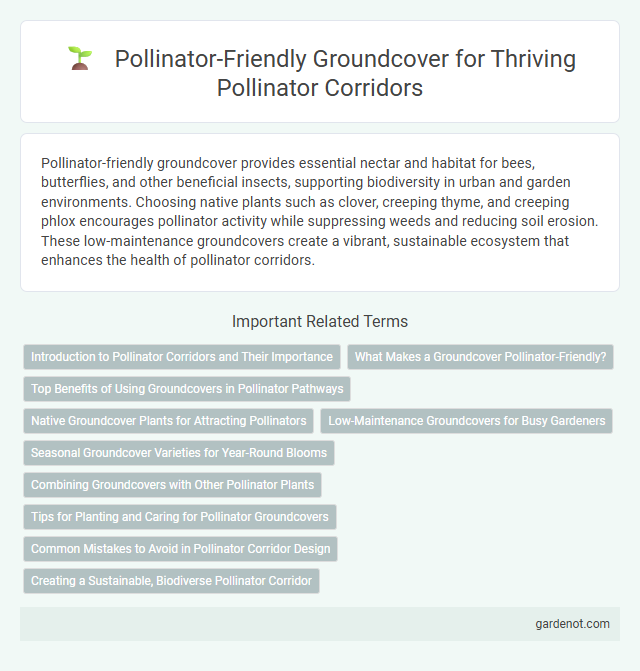Pollinator-friendly groundcover provides essential nectar and habitat for bees, butterflies, and other beneficial insects, supporting biodiversity in urban and garden environments. Choosing native plants such as clover, creeping thyme, and creeping phlox encourages pollinator activity while suppressing weeds and reducing soil erosion. These low-maintenance groundcovers create a vibrant, sustainable ecosystem that enhances the health of pollinator corridors.
Introduction to Pollinator Corridors and Their Importance
Pollinator corridors are strategic plant pathways that connect fragmented habitats, enabling bees, butterflies, and other pollinators to thrive by providing continuous access to nectar and pollen sources. Pollinator-friendly groundcovers play a critical role in these corridors by offering diverse, low-growing floral resources that support pollinator foraging and nesting while reducing soil erosion. Integrating native, drought-tolerant groundcovers enhances biodiversity, boosts ecosystem resilience, and promotes pollination services essential for agricultural productivity and natural plant reproduction.
What Makes a Groundcover Pollinator-Friendly?
Pollinator-friendly groundcovers feature native flowering plants rich in nectar and pollen that attract bees, butterflies, and other beneficial insects. These groundcovers provide continuous bloom periods and diverse floral structures, accommodating various pollinator species and supporting their foraging needs. Low-maintenance, pesticide-free varieties with dense foliage also offer shelter and habitat, enhancing pollinator survival and biodiversity in corridors.
Top Benefits of Using Groundcovers in Pollinator Pathways
Pollinator-friendly groundcovers enhance habitat connectivity by providing continuous foraging resources and shelter for bees, butterflies, and other pollinators within pollinator corridors. These groundcovers improve soil health and moisture retention, creating a sustainable environment that supports diverse pollinator species year-round. Promoting native flowering groundcovers encourages biodiversity and strengthens ecosystem resilience in urban and rural landscapes.
Native Groundcover Plants for Attracting Pollinators
Native groundcover plants such as creeping thyme, wild strawberry, and bearberry provide essential nectar and pollen resources that support a variety of pollinators including bees, butterflies, and hummingbirds. These low-growing species enhance biodiversity by creating continuous floral displays and safe habitats for pollinator foraging and nesting. Incorporating native groundcovers into pollinator corridors improves ecosystem resilience and promotes sustainable pollination services in urban and natural landscapes.
Low-Maintenance Groundcovers for Busy Gardeners
Low-maintenance groundcovers such as creeping thyme, clover, and sedum create an ideal pollinator corridor by providing continuous nectar sources for bees and butterflies with minimal upkeep. These plants thrive in various soil conditions, reduce weed growth, and require less watering, making them perfect for busy gardeners seeking sustainable landscaping solutions. Incorporating native pollinator-friendly groundcovers enhances biodiversity while supporting local ecosystems and promoting healthy pollinator populations.
Seasonal Groundcover Varieties for Year-Round Blooms
Seasonal groundcover varieties such as creeping thyme, ajuga, and clover provide continuous blooms that support pollinators throughout the year. These low-growing plants attract bees, butterflies, and other beneficial insects by offering nectar and pollen during different seasons. Incorporating diverse groundcovers ensures a sustainable pollinator corridor with consistent food sources across spring, summer, fall, and winter.
Combining Groundcovers with Other Pollinator Plants
Integrating pollinator-friendly groundcovers with native flowering plants such as milkweed, lavender, and coneflowers enhances habitat diversity and supports a wider range of pollinator species. Low-growing groundcovers like creeping thyme and clover provide continuous nectar sources and nesting sites, complementing taller, nectar-rich plants that attract bees, butterflies, and hummingbirds. This strategic layering improves pollinator foraging efficiency and increases pollination success across the corridor ecosystem.
Tips for Planting and Caring for Pollinator Groundcovers
Select native, low-growing pollinator-friendly groundcovers such as creeping thyme, sweet alyssum, or sedum to create a thriving corridor that supports bees, butterflies, and other beneficial insects. Ensure soil preparation by loosening compacted soil and incorporating organic matter to improve drainage and nutrient availability, which promotes healthy root development. Regular watering during establishment, mulching to retain moisture, and avoiding pesticide use are essential practices to maintain vibrant and resilient pollinator groundcover habitats.
Common Mistakes to Avoid in Pollinator Corridor Design
Choosing non-native or invasive groundcovers can disrupt local ecosystems and reduce pollinator diversity within pollinator corridors. Overplanting a single species limits floral resources, negatively impacting pollinator health and foraging efficiency. Avoid dense, low-growing plants that block taller blooming species, ensuring a layered habitat that supports a broad range of pollinators.
Creating a Sustainable, Biodiverse Pollinator Corridor
Pollinator-friendly groundcovers such as clover, creeping thyme, and native wildflowers enhance habitat connectivity by providing continuous forage and shelter for bees, butterflies, and other pollinators. These low-growing plants improve soil health, reduce erosion, and require minimal maintenance, supporting a resilient and sustainable pollinator corridor. Incorporating diverse species tailored to local ecosystems ensures year-round blooms, maximizing nectar and pollen availability to sustain pollinator populations.
Pollinator-friendly groundcover Infographic

 gardenot.com
gardenot.com